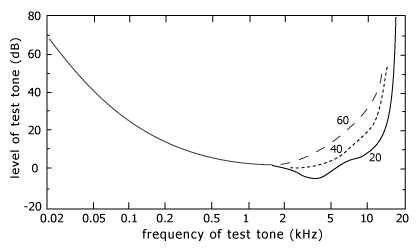Absolute Threshold of Hearing: Difference between revisions
Mix de Rax (talk | contribs) No edit summary |
m (ATH moved to Absolute Threshold of Hearing) |
||
| (9 intermediate revisions by 4 users not shown) | |||
| Line 1: | Line 1: | ||
The | The '''Absolute Threshold of Hearing''' ('''ATH''') is the volume level at which one can detect a particular sound 50% of the time. If one has a low absolute threshold, it means that he is able to detect small amounts of stimulation, and thus is more sensitive. If one has a high absolute threshold, then he requires more stimulation and thus is less sensitive. | ||
The following are curves of the ATH for several age groups over [[frequency]]. Zwicker approximated these curves from experiments on a number of subjects: | The following are curves of the ATH for several age groups over [[frequency]]. Zwicker approximated these curves from experiments on a number of subjects: | ||
The ATH is the simplest property of human hearing to exploit | [[Image:ATH.png|frame|none|ATH graph for different age-groups]] | ||
The ATH is the simplest property of human hearing to exploit when designing a psychoacoustics model. | |||
==References== | |||
* Zwicker, Eberheart. Psychoacoustics: Facts and Models. Berlin: Spring-Verlag, March 1999: Edition: 5th ISBN 3-540-65063-6 | |||
[[Category:Psychoacoustics]] | |||
Latest revision as of 16:44, 13 June 2007
The Absolute Threshold of Hearing (ATH) is the volume level at which one can detect a particular sound 50% of the time. If one has a low absolute threshold, it means that he is able to detect small amounts of stimulation, and thus is more sensitive. If one has a high absolute threshold, then he requires more stimulation and thus is less sensitive.
The following are curves of the ATH for several age groups over frequency. Zwicker approximated these curves from experiments on a number of subjects:

The ATH is the simplest property of human hearing to exploit when designing a psychoacoustics model.
References
- Zwicker, Eberheart. Psychoacoustics: Facts and Models. Berlin: Spring-Verlag, March 1999: Edition: 5th ISBN 3-540-65063-6
